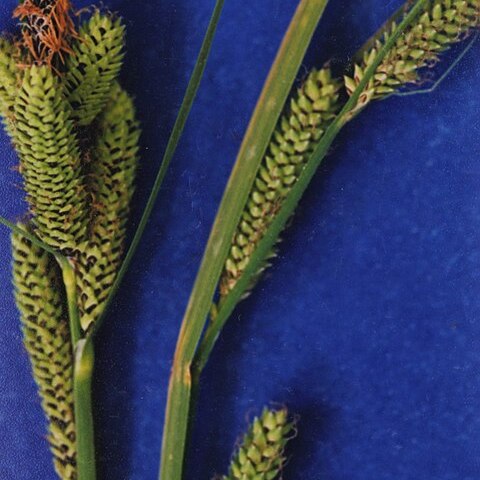Densely tufted, with very short or no rhizomes, the flowering stems 2–8 dm, surrounded by lf-bases of the previous year; lvs mostly 2–4 mm wide, V-shaped in x-section, with papillae and stomates on both sides, lacking palisade tissue; spikes 3–6, approximate or ± remote, erect, sessile or the lower ± evidently pedunculate, all slender (more so than in no. 188 [Carex paleacea Wahlenb.) and ± elongate, mostly (1–)1.5–5 cm, seldom appreciably over 5 mm thick, the terminal one staminate, less often gynaecandrous or with a few basal perigynia, the others generally pistillate; bract subtending the lowest spike elongate, commonly surpassing the infl, sheathless or with a short white sheath, the others more reduced; pistillate scales reddish-brown to sometimes blackish or dark brown, with a conspicuous broad pale or green midstrip, commonly shorter than and exposing the perigynia, these 1.7–3.2 mm, somewhat compressed, lanceolate to ovate or broadly elliptic, 2-ribbed, 3–7-nerved on each face, short-stipitate and with a slender, terete, entire, often black-tipped beak 0.1–0.3 mm, the body commonly greenish distally, papillate only on the upper third; achene lenticular, whitish-iridescent, distinctly shorter than the perigynial cavity, adnate below to the swollen perigynium-base; 2n=86–92. Wet shores and beaches; Lab. to Alas., s. to Mass., N.Y., Wis., Minn., and Calif.; e. Asia. Ours is var. lenticularis.
More
Plants cespitose. Culms obtusely angled, glabrous. Leaves: basal sheaths brown; sheaths of proximal leaves glabrous, fronts lacking spots and veins, entire, apex truncate, somewhat prolonged; blades amphistomic, papillose on both surfaces. Proximal bract longer than inflorescence. Spikes erect; proximal 3–4 spikes pistillate, base cuneate or attenuate; terminal 1 spike staminate. Pistillate scales pale brown or black, shorter than perigynia, apex obtuse, awnless. Perigynia ascending, green, veined, tightly enclosing achenes, thin-walled, ellipsoid or ovoid, dull, base truncate, distended, apex acute, glabrous. Achenes not constricted, glaucous.


